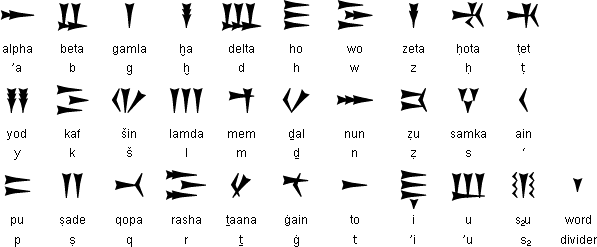Origin
Ugaritic cuneiform was named after Ugarit, the city state where it was used in what is now Syria. It was probably created sometime during the 14th century BC.Notable features
- Ugaritic cuneiform outwardly resembles other cuneiform scripts and has a sound system based on consonant alphabets such as Phoenician/Canaanite.
- Ugaritic was generally written from left to right in horizontal rows, though there are examples of it written in the opposite direction.
- Words were divided with a slash, no other punctuation was used.
Used to write:
Ugaritic, a Semitic language closely related to Phoenician which was spoken in the city state of Ugarit in northern Syria. Ugarit flourished from the 14th century BC until 1180/70 BC, when it was destroyed.The city was rediscovered in 1928 by a peasant whose plow uncovered an ancient tomb near Ras Shamrah in northern Syria. A group of French archaeologists led by Claude F.A. Schaeffer started excavating the city in 1929.

Links
Information about the Ugaritic alphabet and languagehttp://en.wikipedia.org/wiki/Ugaritic_alphabet
http://en.wikipedia.org/wiki/Ugaritic_language
Information about the city of Ugarit
http://en.wikipedia.org/wiki/Ugarit
Ugaritic fonts
http://davidmyriad.tripod.com/myriads.font.page.html
http://www.fontspace.com/category/ugarit
http://www.historian.net/files.htm
http://reinhold.kainhofer.com/rk_fonts/index.html
ALPHABETUM - a Unicode font
specifically designed for ancient scripts, including classical
& medieval Latin, ancient Greek, Etruscan, Oscan, Umbrian,
Faliscan, Messapic, Picene, Iberian, Celtiberian, Gothic, Runic,
Old & Middle English, Hebrew, Sanskrit, Old Nordic, Ogham,
Kharosthi, Glagolitic, Old Cyrillic, Phoenician, Avestan, Ugaritic,
Linear B, Anatolian scripts, Coptic, Cypriot, Brahmi, Old Persian cuneiform:
http://guindo.pntic.mec.es/~jmag0042/alphabet.html









.jpg)
.jpg)

.jpg)





0 comments:
Post a Comment
Note: Only a member of this blog may post a comment.